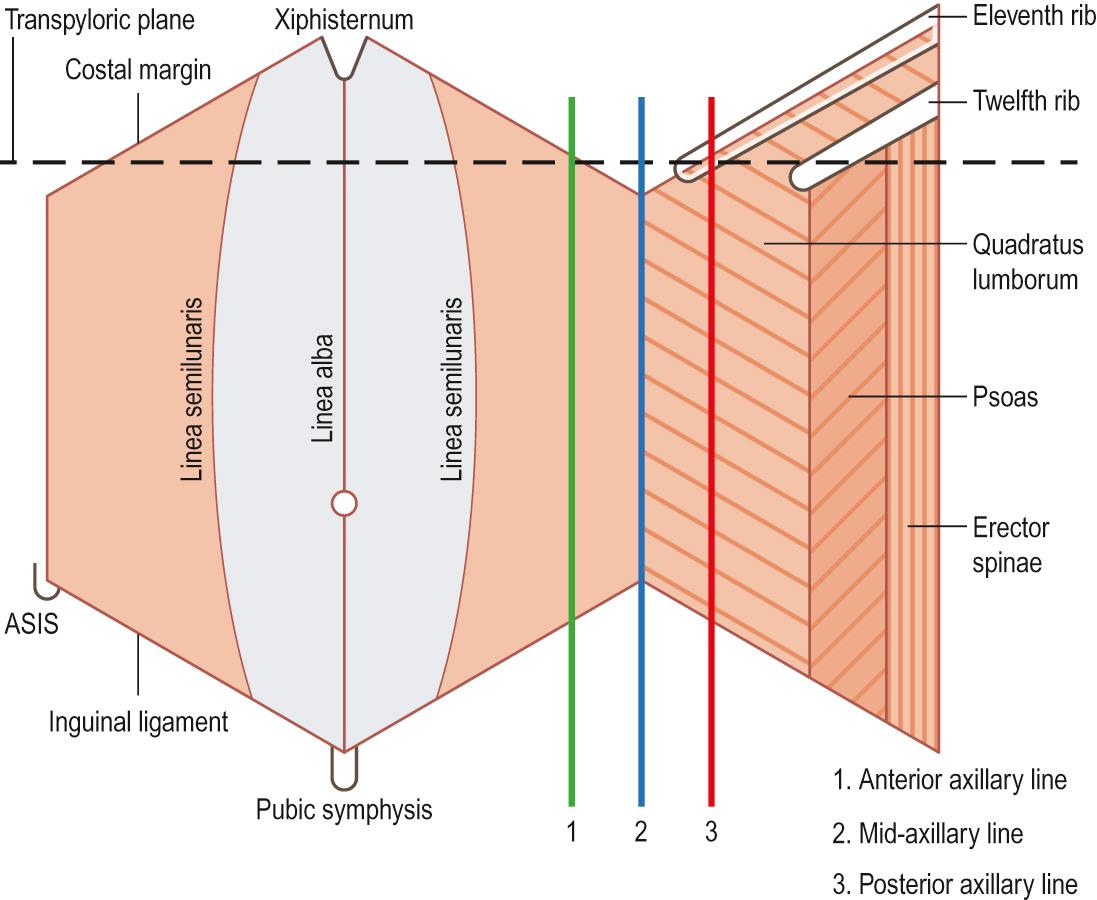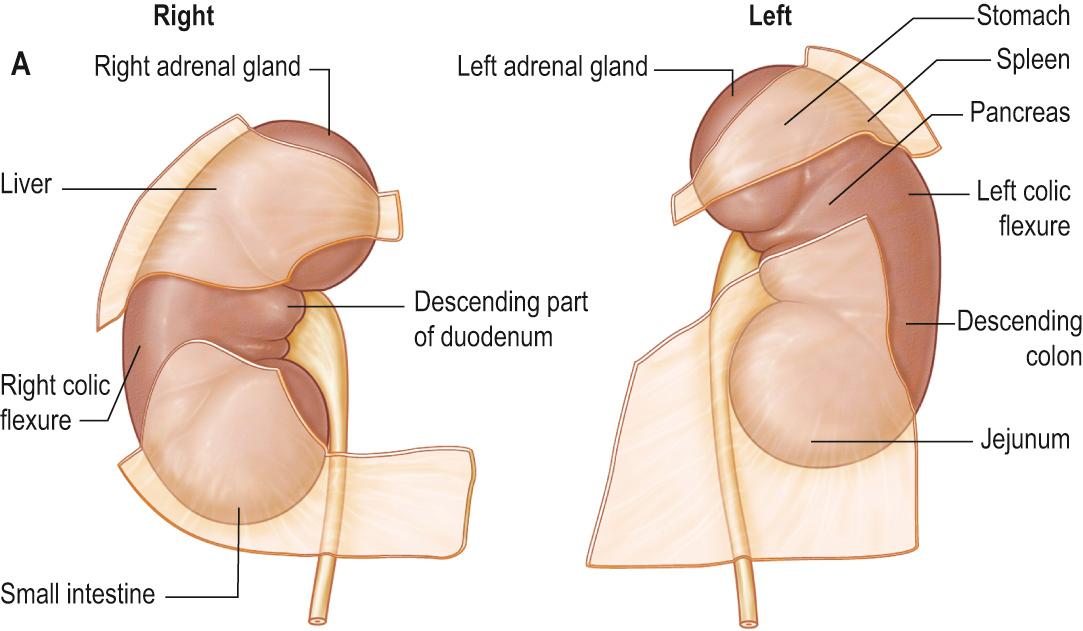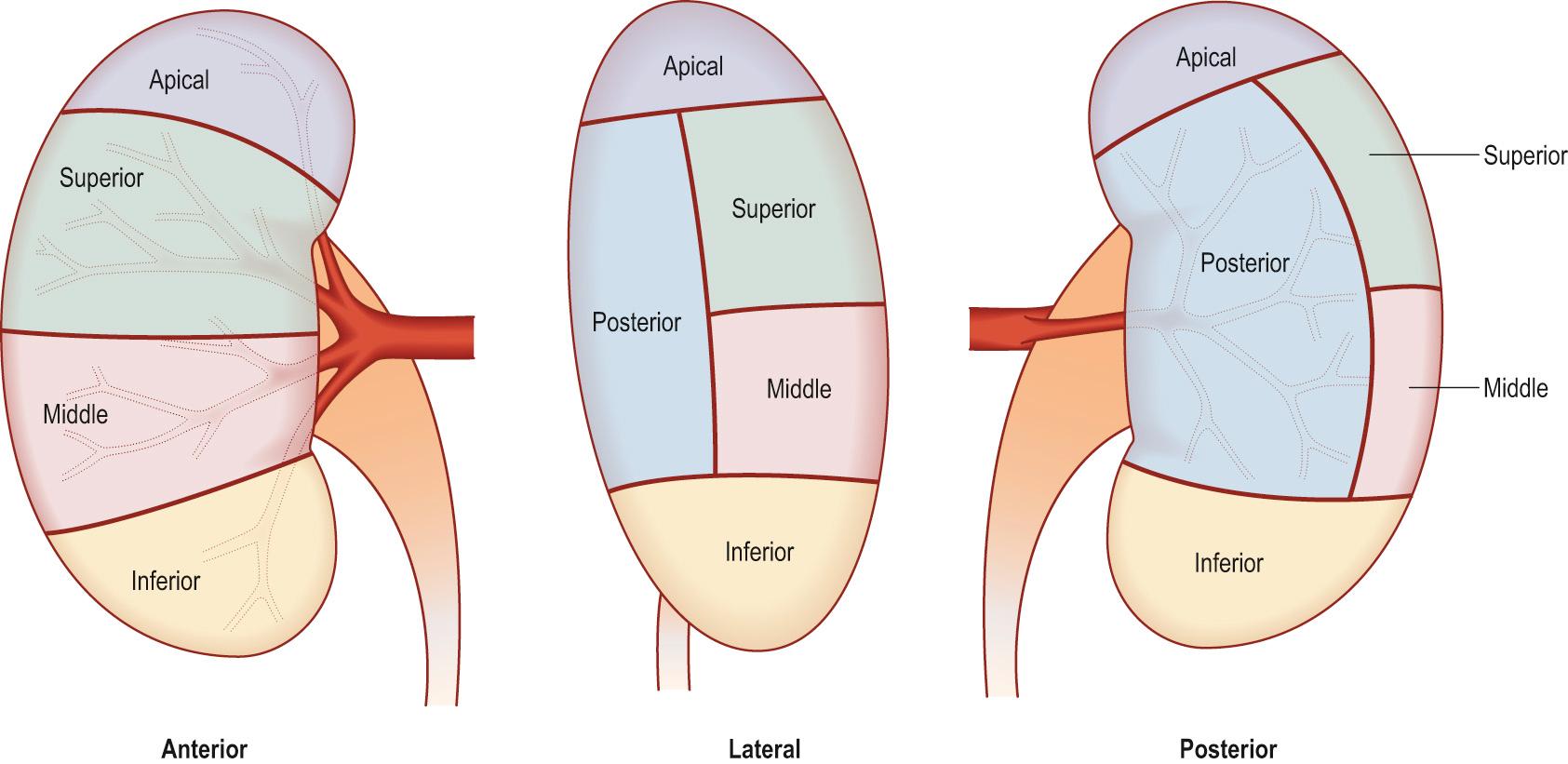Physical Address
304 North Cardinal St.
Dorchester Center, MA 02124
Open nephrectomy
Open partial nephrectomy
Robotic/laparoscopic nephrectomy
Robotic/laparoscopic partial nephrectomy
Open nephro-ureterectomy
Robotic/laparoscopic nephro-ureterectomy
Robotic/laparoscopic pyeloplasty
Percutaneous nephrolithotomy
Nephrostomy
Extracorporeal shock wave lithotripsy
Ureteroscopy ± retrograde pyelogram/laser or lithoclast lithotripsy/biopsy/stent
Pyeloscopy ± laser/biopsy/stent
This chapter contains an overview of the topographical and surface anatomy of the kidneys and ureters, and their relevance in common surgical procedures.
The kidneys have an essential physiological function in maintaining electrolyte and water balance while excreting the end-products of metabolism. They also have endocrine functions, producing and releasing erythropoietin, which affects red blood cell formation; renin, which influences blood pressure; and 1,25-dihydroxy cholecalciferol, the metabolically active form of vitamin D.
Common surgical pathologies that affect the kidneys vary from neoplastic growths requiring extirpation; obstruction requiring initial internal or percutaneous drainage, with subsequent decompression if due to stones; excision if malignant; or rerouting if anatomically or functionally requiring an orthotopic reconstruction.
The kidney is derived from the sequential development of the pronephros, mesonephros and, ultimately, the metanephros, forming the definitive kidney. The ureter is derived from the ureteric bud, which differentiates to form the pelvis, calyces and collecting ducts. Development is induced by metanephric mesenchyme, while a reciprocal induction leads to the metanephric mesenchyme forming nephrons. Any derangement of this relationship can result in embryological variants or absence, along with mesonephric (Wolffian) duct structures, the epididymis, vas deferens and seminal vesicles.
In the fetus and the newborn, the kidney normally has 12 lobules; in the adult, these lobules are fused to present a smooth surface, although traces of lobulation may remain and can mimic a renal mass on radiographic imaging. Horseshoe kidneys are found in 1 in 400 individuals. A transverse bridge of renal tissue, the isthmus, connects the two renal masses, usually lying between the inferior poles. Most commonly, it lies anterior to the great vessels and inferior to the inferior mesenteric artery, which obstructs its ascent during embryological development. The vascular supply is usually multiple and unpredictable; one vessel to each moiety is seen in only 30%, while the ureters curve anterior to the isthmus and often have a high insertion into the renal pelvis, where crossing vessels or de novo pelvi-ureteric junction obstruction causes hydronephrosis.
In a complete duplex system, the ureter from the upper pole of the kidney (the longer ureter) inserts more medially and caudally in the bladder than the ureter from the lower pole (Weigert–Meyer rule). This reflects the embryological development of the ureter: the ureteric bud that is initially more proximal on the mesonephric duct has a shorter time to be pulled cranially in the bladder and so it inserts more distally in the mature bladder. The clinical/surgical implication is that the upper moiety can obstruct while the lower moiety is often refluxing.
The urological surgeon should be aware that kidneys may be atypically located: they may be pelvic, ectopic or crossed fused ectopic, and may even be absent. Failure of the kidney to ascend into the renal fossa in utero results in renal ectopia. An ectopic kidney is found in the pelvis in 1 in 2500 live births; these kidneys often have associated malrotation anomalies and exhibit marked fetal lobulation. A single absent kidney, resulting from the failure of the metanephric blastema to join a ureteric bud on the affected side, is seen in 1 in 1200 individuals. There are no clinical sequelae, but the ipsilateral vas deferens and/or epididymis may also be absent and there may be other congenital anomalies.
Anterior landmarks inform the placement of incisions or ports required for surgical access, typically through a transperitoneal route. From the midline, the xiphisternum denotes the apex, the costal margin forms the superior boundary, and the anterior superior iliac spine (ASIS), inguinal ligament and pubic symphysis denote the inferior abdominal boundary; the umbilicus, linea semilunaris and linea alba are all relevant surface markings. The transpyloric plane (defined by the intersection of the mid-clavicular line with the costal margin at around the ninth costal tip) is a reference point for various abdominal organs ( Fig. 69.1 ).

Posterior landmarks inform surgical access either when the aim is to remain in the retroperitoneal space or when performing percutaneous stone surgery. The anterior, mid- and posterior axillary lines and the prominence of the eleventh and twelfth ribs should be noted. The posterior superior iliac spine (PSIS) and the sacroiliac joint are inferior fixed landmarks. Pleural reflections are based on thirds along the twelfth rib; the lateral third is below the pleura, the mid third has a variable relationship to the pleura, and the medial third overlies the pleura. Psoas major is used as the most medial/posterior plane to establish retroperitoneal access. Quadratus lumborum lies lateral to psoas major.
The main renal vessels have surface markings along the transpyloric plane and hence most minimally invasive surgery will be mindful of this plane in planning access. The inferior epigastric vessels run craniocaudal 8 cm lateral to the midline and must be avoided when placing laparoscopic trocars.
In the fresh state, the kidneys are reddish brown and are situated posteriorly behind the peritoneum, on each side of the vertebral column. They are surrounded by adipose tissue of varying thickness and adherence. In adults, each kidney is typically 11 cm in length, 6 cm in breadth and 3 cm in anteroposterior dimension; male kidneys are slighter larger than female kidneys. Superiorly, the kidneys are level with the upper border of the twelfth thoracic vertebra, and inferiorly, with the third lumbar vertebra ( Fig. 69.2 ). The right is usually slightly inferior to the left, reflecting its relationship to the liver. The left is a little longer and narrower than the right and lies nearer the median plane. The long axis of each kidney is directed inferolaterally and the transverse axis is directed posteromedially, which means that the anterior and posterior aspects, as usually described, are actually anterolateral and posteromedial. An appreciation of this orientation is important in percutaneous and endo-urological renal surgery.

Kidneys may be malrotated, duplicated, horseshoe or even absent, and retroperitoneal, pelvic or ectopic. Crossed ectopia is related to aberrant interaction between the mesonephros and ureteric bud during development.
Renal vascular anatomy is important, particularly when undertaking partial nephrectomy.
The paired renal arteries take about 20% of the cardiac output. They branch laterally from the aorta, just below the origin of the superior mesenteric artery at vertebral level L2.
A single renal artery to each kidney is present in approximately 70% of individuals; the arteries vary in their level of origin, calibre, obliquity and relations. Each renal artery gives off one or more adrenal arteries, a branch to the ureter, and branches that supply perinephric tissue, the renal capsule and the pelvis. Near the renal hilum, the renal artery divides into anterior and posterior divisions that further divide into segmental arteries supplying the renal vascular segments ( Fig. 69.3 ). Five arterial segments have been identified: apical, superior, middle and inferior segments anteriorly, and the whole posterior region between the apical and inferior segments posteriorly. While there can be considerable variation in this pattern, it is important to emphasize that vascular segments are supplied by virtual end arteries.

Brödel described a relatively avascular longitudinal zone (the ‘bloodless’ line of Brödel) along the convex renal border, which was proposed as the most suitable site for surgical incision to access the inner kidney. While, theoretically, this zone lies between the anterior and posterior segmental divisions, in practice many vessels cross it, which means that planned radial or intersegmental incisions are preferable. The subdivisions of the renal arteries are described sequentially as segmental; lobar (one to each renal pyramid); interlobar (extending to the cortex around each pyramid); arcuate (forming at the corticomedullary junction); and interlobular arteries (extending radially into the cortex).
Accessory renal arteries occur in approximately 30% of individuals and are usually inferior to the main renal artery, where they may cause obstruction: for example, in cases of pelvi-ureteric junction obstruction.
Become a Clinical Tree membership for Full access and enjoy Unlimited articles
If you are a member. Log in here